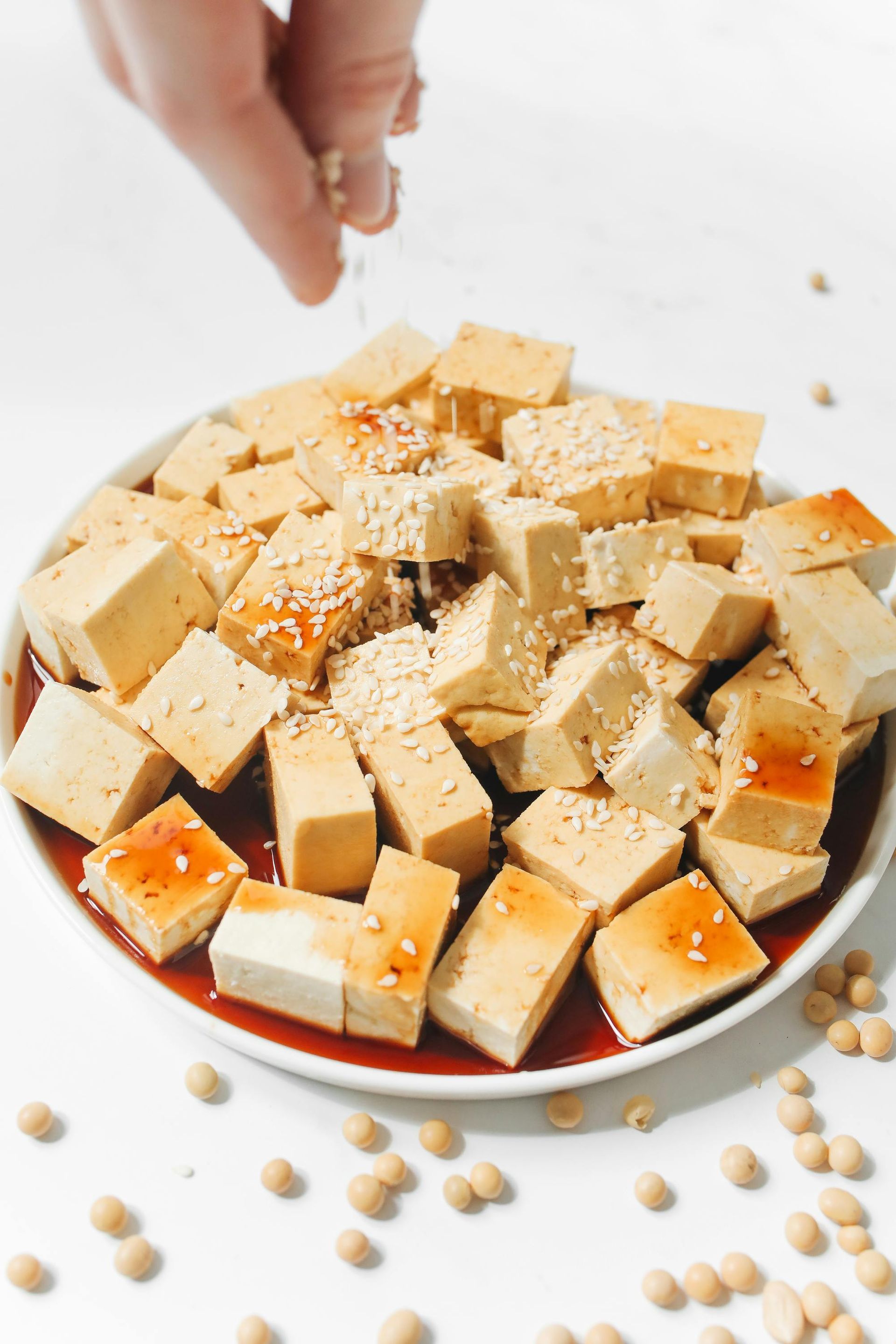How not to feel crazy around cookies
July 12, 2020
Written By: Nutrition Coach Mairead
The other day I was sitting watching Netflix with my husband and he grabbed the cookies from the kitchen. I ate one, realized they weren't quite as good as I thought, and went back to watching tv. While this seems like a super boring story to some, I also work with tons of clients who feel crazy around any treat foods, even if it's ones they don't really like!
"I just feel like I need to eat all the sugar if it's in front of me, even if it's not something I like. I can't stop!"
Does this sound like you? I get it and I've been there. And taking the stress out of food feels so good! It's not that I've developed tons of willpower or that I'm super disciplined. It's that I truly approach food knowing that all foods fit all the time.
If we feel like we "can't be trusted" with certain foods around or feel like we can't even keep them in the house, it's often because we're putting rules around them.
Maybe you tell yourself you can only eat them at a certain time or on a certain day. Maybe it's that you can only have one and it puts the pressure on that one eating experience to be perfect. The more we restrict something, the more we end up wanting it so much more and feeling crazy around it! If we know we're not going to let ourselves eat it later, we want to get as much as we can while it's in front of us.
Part of the solution? To let go of your food rules. Let go of all the things you tell yourself you can't have and eat them without stressing.
Enjoy your favourite treat foods regularly and really take the time to enjoy them. Will this feel weird at first? Yep. But every time you get to eat without guilt, it will feel just a little bit better. Someday you too will be able to keep cookies in the house all the time without feeling out of control.
Want some help letting go of your own food rules? Let's chat! Email mairead@degreefitnessseaforth.com to chat about your goals, or click here for more info

Written By: Mairead, Registered Dietitian When it comes for nutrition for fitness goals, many of us are concerned about protein. After all, protein helps repair and build muscles, as well as helping us feel fuller longer, and keeping our energy levels stable throughout the day. But protein foods, like meat, can be expensive! For those trying to watch your grocery budgets, or maybe just trying to include more variety in your protein sources, let's check out some less-expensive options! 1. Canned tuna! Fish is a fantastic lean protein source, and none are more convenient than canned tuna. While you can find fancy flavoured cans of individual servings, a 170g can of plain tuna is often only $2.00, meaning it's only $1.00 for a 3oz serving, with rougly 20g of protein! Plain tuna can easily be dressed up with your favourite seasonings, sauces, pickles... the list goes on! Try adding tuna to basic salads, using it as a sandwich filling, or creating rice bowls with your favourite veggies and some spicy tuna! 2. Canned beans! We all know beans pack a fibre punch, but did you know they're also a good source of protein? Canned beans can be quick and convenient - just open, drain, rinse, and go! A can of black beans can be found for only $1.79 and contains roughly three 1/2 cup servings, making each serving only $0.60, and packing in 8g of protein. Try pairing beans with whole grains like quinoa or brown rice, or use it to pump up both the fibre and protein in meat-based dishes. 3. Eggs! Eggs go way beyond breakfast! A carton of 12 eggs is $3.93, making each serving of two eggs roughly $0.66, with 12g of protein. Eggs can be an easy topping for bowl meals and salads, a convenient snack when hardboiled, or served with good old traditional toast for those who like to keep it simple. 4. Tofu! Many people claim not to like tofu, but most just don't know how to use it! Made from soybeans, tofu is a good vegan source of iron, and will take on the flavour of anything it is cooked or marinated in. A 350g package of extra-firm tofu can cost as low of $2.79, making each 85g serving $0.70, with 14g of protein. Try tofu in a flavourful stir-fry, or marinate it ahead of time for a quick protein addition for salads and bowls. 5. Edamame! Edamame are green soy beans, and are easy to find with the frozen vegetables. To use, they just need to be defrosted! A 500g bag of frozen edamame is roughly $5.00, making each 85g serving cost about $0.85, with 9g of protein, and a bonus 4g of fibre! Try adding edamame to your favourite stir fry or salad. While edamame is often used in Asian dishes, it's mild flavour makes it easy to incorporate anywhere. Did the price on any of these surprise you? Will you try a new-to-you protein idea? One of the keys to a balanced diet is variety, and including different sources of protein can help you meet your protein needs without blowing your budget! Looking for more personalized nutrition advice? Let's chat! Email mairead@degreefitnessseaforth.com to learn more about our Nutrition Programs, or click HERE to book your FREE Bite-Sized Nutrition Chat!

Written By: Mairead, Registered Dietitian Have you heard of the "Complexity Bias"? This is the idea that the more complicated something is, the more effective and accurate we perceive it to be. In terms of exercise, this could look like very complicated plans, complex movements, and fancy equipment. When it comes to nutrition, we often see this look like overly complicated food rules and diet plans. All over the internet, you can find lists of foods to eat or avoid, specific times to eat, combinations of foods you need to eat together... the variations of complicated rules can go on and on. Just because something looks fancy on paper, that doesn't mean it's actually going to be effective for your goals, or even that it's technically true! However, we are often drawn to these more complicated diet plans and rules. They can make us feel good, like we've got it "right", and give us a sense of control. If we're eating our prescribed 137.5 grams of protein, we've got to be on the right track, right? Diet plans that are too complicated can actually make it harder to reach our goals. The more complicated something is, the harder it is to keep doing, day after day, especially when things are busy or you're even slightly out of routine. While nutrition is highly complex, the important parts for most people actually boil down to the basics, which are fairly simple and not hyper-specific. Eat lots of vegetables and fruit, and aim for variety with this. Eat some sort of protein at most meals and snacks, and aim for some variety in your protein sources. Include healthy fats in your diet daily. Again, aim for some variety. Eat on a fairly consistent schedule. Come to your meals and snacks hungry enough to eat and enjoy your food, but not so ravenous that you won't even taste your food. Drink enough water. Eat pretty well most of the time, and don't sweat the occasional treat. For most normal healthy people, these habits will improve your diet quality and nutritional intake way more than any complicated rules will. Remember, for nutrition habits to work, you need to able to maintain them. And if you're going to maintain them, they can't be too complicated. Looking for more personalized nutrition help? Let's chat! Our Dietitian is now scheduling for Nutrition Programs again! Email mairead@degreefitnessseaforth.com for more info, or click HERE to book your FREE Bite-Sized Nutrition Chat!

Written By: Mairead, Registered Dietitian February is Heart Health Month! So what better time to focus on habits that can help improve our cardiovascular (or heart) health! Cardiovascular disease includes high blood pressure, high cholesterol, and coronary artery disease. All of these factors can increase your risk of having a heart attack or stroke. While some of your risk is genetic, many factors can be improved with lifestyle habits - which are in our control! Check out these ways you can improve your heart health this Heart Health Month! Know your risk level Many people may be walking around with high cholesterol or high blood pressure and not know it. If we don't know something is a problem, we can't fix it! Make sure to complete any tests your doctor recommends in a timely manner, and follow up afterwards. If you do find out there's a problem, it's much easier to start making changes when something is a smaller potential risk factor than after something serious has happened. Not sure where you're at? Ask your doctor if this is something you should monitor! Get enough exercise We don't have a magic pill that fixes everything, but exercise does come close! For heart health, exercise will help decrease your blood pressure and promote healthy cholesterol levels. The recommendation for most healthy Canadian adults is to aim for 150 minutes of "moderate to vigorous" exercise a week - this means your heart rate is up and you are breathing at least a bit harder than at rest. If you feel you fall short of that goal, try slowly increasing by 5-10 minutes a week as your body allows. Any type of exercise that gets your heart rate up counts! Watch your salt intake While we know we do need some salt or sodium in our diet, many of us eat too much salt. Much of this comes from processed foods or take out - it's not just about whether you add salt during cooking and at the table. For those who are at risk for high blood pressure, a high sodium intake can increase that risk, and decreasing your salt intake can help promote more normal blood pressure. Staying between 1800mg and 2300mg of sodium daily will make sure your body is getting what it needs without overdoing it. Try checking your labels to see if you're taking in more salt than you realize. Use the "percent daily value" on the right-hand side of the nutrition facts table - remember, 5% is a little bit, 15% is a lot! Increase your fibre intake Fibre does many great things for our body - including helping to improve your cholesterol levels, or maintain them in a healthy range. The total recommended amount of fibre daily is 20-25g for women and 30-38g for men - that's a lot!! Sources of fibre include vegetables, fruit, whole grains and whole grain products, nuts and seeds, and legumes. If you're choosing foods with a nutrition label, use the "percent daily value" to choose higher-fibre options. Remember to make changes in your fibre slowly and make sure you're properly hydrated to avoid any bowel upset. Remember, health isn't all or nothing! If you're ready to improve your heart health, pick one habit to focus on and figure out how you can implement in your daily life consistently! Looking for more personalized nutrition advice? Let's chat! Email mairead@degreefitnessseaforth.com for more information about our Nutrition Programs, or click HERE !
